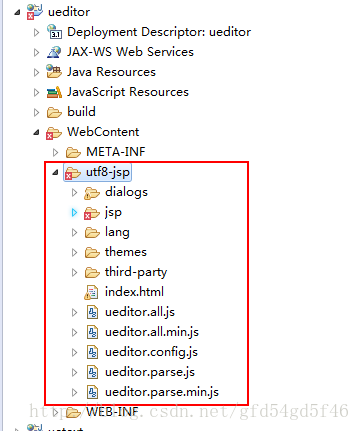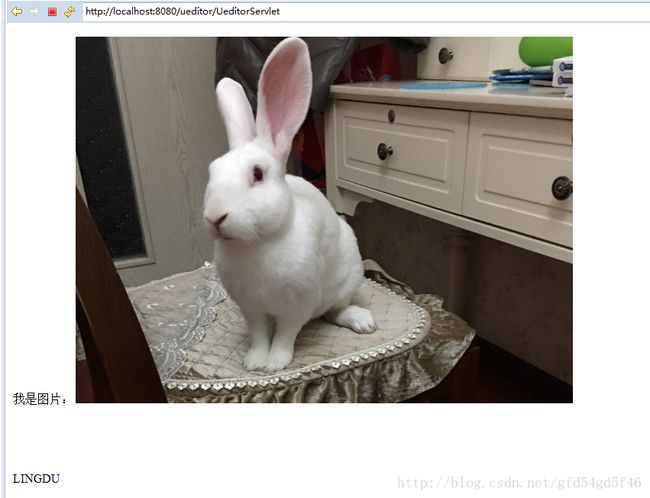UEditor在JavaWeb中的应用
富文本编辑器(UEditor)
在平时开发Java Web项目的时候,往往会使用第三方插件来帮助我们更快的实现功能。
这里教大家使用百度开源的富文本编辑器(UEditor)来帮助我们更好的编写文本。
官网下载地址
http://ueditor.baidu.com/website/download.html
这里下载最新版的就可以了
解压出来是这样的
打开index.html的效果
好了 ,废话不多说,开始我们的正题。
1、配置编辑器环境
创建一个动态web工程
将解压出来的编辑器文件夹整个拷贝到WebContent目录下
此时工程会报错,因为我们没有引用所需的jar包。
将utf8-jsp -> jsp->lib目录下中的所有jar包拷贝到WEB-INF目录下的lib文件夹中
在WebContent下创建一个index.jsp的文件。
将utf8-jsp中的index.html文件内容拷贝到index.jsp
注:使用插件时必须引入以下3个文件
<script type="text/javascript" charset="utf-8" src=" ueditor.config.js">script>
<script type="text/javascript" charset="utf-8" src=" ueditor.all.min.js"> script>
<script type="text/javascript" charset="utf-8" src=" lang/zh-cn/zh-cn.js">script>
调用编辑器:
<script id="editor" type="text/plain" style="width:1024px;height:500px;">script>
初始化编辑器:
<script type="text/javascript">
//实例化编辑器
//建议使用工厂方法getEditor创建和引用编辑器实例,如果在某个闭包下引用该编辑器,
//直接调用UE.getEditor('editor')就能拿到相关的实例
var ue = UE.getEditor('editor');
script>
将引用js文件的相对路径补全
完成之后运行index.jsp或者右键工程运行
这样基本的配置就搭建好了。
2、获取编辑框的内容
我们来使用富文本编辑器随便写一些内容,然后点击获取内容
我们发现,在javaScript中可以使用 editor.getContent()获得整个p标签的内容,那我们怎么在java web中拿到内容呢?
回到index.jsp中
使用form表单将整个 编辑器包涵,并且加上用于提交表单的按钮
<body>
<div>
<form action="">
<h1>完整demoh1>
<script id="editor" type="text/plain"
style="width:1024px;height:500px;">script>
<button type="submit">提交button>
form>
div>
<script type="text/javascript">
//实例化编辑器
//建议使用工厂方法getEditor创建和引用编辑器实例,如果在某个闭包下引用该编辑器,直接调用UE.getEditor('editor')就能拿到相关的实例
var ue = UE.getEditor('editor');
script>
body>
将多余的按钮以及js脚本都删除,保留一个实例化编辑器的方法
var ue = UE.getEditor('editor');
运行之后 编辑一段内容然后点击提交
http://localhost:8080/ueditor/index.jspeditorValue=%3Cp%3E%E6%88%91%E6%98%AF%E5%86%85%E5%AE%B9%3C%2Fp%3E
我们可以发现,在提交表单的时候数据是保存在editorValue下的,知道原理之后我们就可以创建一个servlet来接收这个字段了
创建Servlet之后还需修改form表单中的action值
<form action="UeditorServlet" method="post">
UeditorServlet .java中的doGet()方法
/**
* 用于接收form表单中的editorValue值
* @see HttpServlet#doGet(HttpServletRequest request, HttpServletResponse response)
*/
protected void doGet(HttpServletRequest request, HttpServletResponse response) throws ServletException, IOException {
//设置请求和响应的编码统一为UTF-8
request.setCharacterEncoding("UTF-8");
response.setCharacterEncoding("UTF-8");
//拿到编辑器的内容
String content = request.getParameter("editorValue");
//如果不为空
if(content != null){
//将内容设置进属性
request.setAttribute("content",content);
//转发到content.jsp
request.getRequestDispatcher("content.jsp").forward(request, response);
}else{
response.getWriter().append("内容为空!");
}
}
Content.jsp页面就简单使用EL表达式接收数据即可
<%@ page language="java" contentType="text/html; charset=UTF-8"
pageEncoding="UTF-8"%>
<html>
<head>
<meta http-equiv="Content-Type" content="text/html; charset=UTF-8">
<title>Insert title heretitle>
head>
<body>
<div>
${content }
div>
body>
html>
运行index.jsp ,随便编辑一段文字提交
这时内容就已经传过来了。
3、配置图片路径
在没有配置图片上传路径的时候,添加一张图片时是显示不出来的
编辑utf8-jsp -> jsp -> lib -> 下的config.json文件
修改图片上传的路径
编辑utf8-jsp目录下的ueditor.config.js
在配置中加入编辑器的路径地址
配置完成之后重启toncat服务器并且运行index.jsp,编写一条图文信息提交
提交之后的结果:
查看图片保存路径可以在jsp中使用以下代码,即可得到工程编译后的路径
<%
//图片保存的路径,可以到这个路径下查看
out.println(request.getRealPath(""));
%>
获取到了根目录位置
简单的配置以及使用就介绍到这里吧。
相关的编辑器配置信息可到 utf8-jsp目录下的ueditor.config.js文件中修改
























